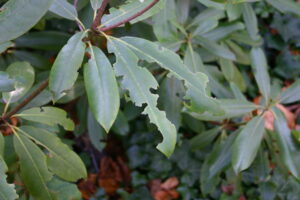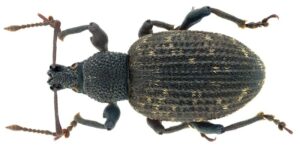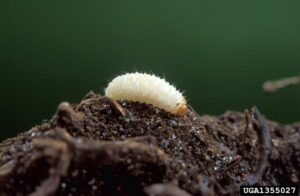Black vine weevil (Otiorhynchus sulcatus) is a serious pest of several ornamental and fruit plants, such as azalea, Cyclamen, caneberries, yew, rhododendron, grape, and strawberry. It is not a widespread issue, but when they occur, infestations can be devastating to a grower. A few larvae can be lethal to a Rhododendron, and the foliage feeding from adults will greatly reduce the value of ornamental plants. Unfortunately, monitoring for these insects is not easy. Adults are nocturnal and difficult to find during routine scouting. Larvae are in the soil and can only be detected through regular soil sampling, which is impractical for a nursery operation. Due to their elusive nature, populations can build without the grower noticing until it is too late.
While black vine weevils might be hard to find, the damage they leave behind is not. The best indicator of the adult weevils is the characteristic feeding damage. Insects will chew from the outside edge of the leaf towards the middle, creating irregular notching.

If you see this kind of damage, you can gently shake the leaves of the plant to attempt to dislodge adults, or thoroughly examine the foliage and the surrounding area. The adults will hide away from sunlight in locations such as cracks in the soil, on the undersides of benches or trays, and around the base of leaf petioles.
Adults weevils are 11 mm long and have black bodies with orange tufts on their elytra.

Larvae are the primary cause of economic harm to the crop due to extensive feeding on the roots of the plants. They are white with brown heads, legless, and covered in small hairs. They are not easy to ID to species in the field and appear similar to many beetle larvae. The presence of these grubs in the soil of susceptible host plants, in addition to notching damage, may indicate black vine weevil presence.

Black vine weevil is a regulated pest in Indiana, and presence of this pest will result in regulation of infested plant material. Landscape professionals would benefit from understanding the signs of black vine weevil to avoid purchasing and moving infested plants. Fortunately, these weevils are flightless, so their movement is extremely limited. Diligent pest monitoring will go a long way to preventing its spread.